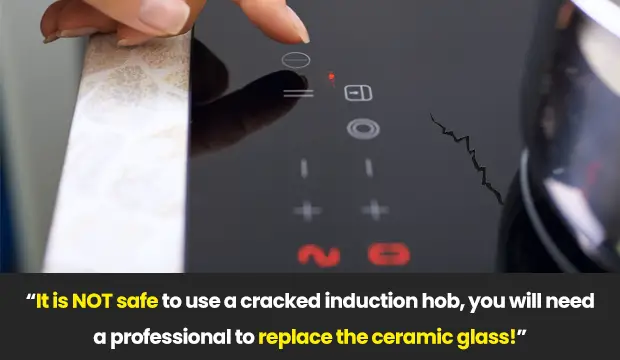An induction hob is a useful and stylish addition to any kitchen. The innovative, electromagnetic system cooks food fast and efficiently. The smooth, ceramic glass surface looks sophisticated and it’s very easy to keep clean.
In fact, it seems almost perfect. But unfortunately, the glass isn’t as resilient as metal. Unless you take a little more care, your beautiful induction hob could actually crack. Here are 10 possible reasons why your induction hob might crack.
Why do Induction Hobs Crack?
- Sudden Impact – Dropping a pan onto the surface can easily crack the ceramic glass. Heavy cast iron pans are obviously the worst culprits, but any type can be hazardous. Make sure your hands are dry when lifting pans to maintain a secure grip.
- Rough Handling – Dragging pans across the ceramic glass can easily scratch the surface. Even shaking a pan to distribute the contents can often strike the glass. If you usually cook on a metal stove, it will take time to learn not to be so rough when using an induction hob.
- Accidental Collison – Any hard object has the potential to crack the ceramic glass. Tins or glass jars falling from a shelf can be particularly damaging. Remove any nearby shelving and don’t store tea caddies or mugs near the hob.
- Food Preparation – Resist the temptation to use your induction hob as an extra work surface simply because it stays cool while cooking. Mixing bowls, metal spoons and knives can cause minor scratches which eventually become weak spots on the surface.
- Correct Size Pans – Wherever possible, always match the pan to the electromagnetic cooking zone. It’s not so damaging to use a smaller pan, but a large base that overhangs can cause the element to overheat. The increased warmth can quickly build up and place increased pressure on any surface scratches.
- Trapped Heat – When you remove a hot saucepan lid, don’t put it on the ceramic glass, particularly on the zone where the pan has just been sitting. The hot air becomes trapped inside the lid and when you pick it up, the contrast between hot and cold air can cause the glass to crack.
- Dry Pan – Preheating a dry pan is not recommended due to the speed of the induction heating process. Forgetting you’ve left a pan cooking runs the risk of it boiling dry. The excessive temperature can crack the glass before the safety mechanism has lowered the heat.
- Spillages – When cooking, try not to spill food on the glass surface. Although spillages won’t continue cooking or become burnt on, they can damage the glass. Sticky, sugary ingredients are often troublesome to wipe away as they burn your fingers. But while the spillage is cooling down, it can cause pitting in the surface of the hob.
- Cold Water – Induction hobs usually remain cool when in use. However, it could be quite warm where a pan has been cooking. Don’t be too hasty to wipe the glass with cold water as the contrasting temperatures could damage the glass.
- Faulty Installation – If your hob has been squeezed into a space that’s too small, the glass can quickly break. When the electromagnetic system is in action, it produces heat which causes a certain amount of expansion. The additional pressure can make the glass split.
Can you replace the glass on a cracked induction hob?

A cracked ceramic glass surface on your induction hob is unsafe to use. It needs an urgent, professional repair. It’s not advisable to attempt replacing the glass yourself.
The circuitry of an induction hob is a tangled mass of complex wiring and if you don’t have any experience, you can easily cause further damage.
A professional electrician understands how to disengage the cracked glass correctly without dropping pieces into the hob’s wiring. The replacement glass also needs to be balanced properly to ensure a safe, seam-free finish.
Is it expensive to fix a cracked induction hob?
Any crack across your induction hob’s glass needs repairing without delay. Unfortunately, it means the entire surface must be replaced.
New glass can usually be obtained from your hob’s manufacturer, but it is expensive as ceramic glass is highly specialised. On average, the glass costs around one-quarter of your hob’s initial purchase price.
An authorised spare part should always be used as it will be precisely tailored to fit your hob’s design. It will also ensure the best performance, making your induction hob as good as new.
Is a Cracked Induction Hob Safe to Use?

If your induction hob ever cracks, it’s not safe to use. Liquids and even steam can leak beneath the surface and produce an electric shock. A cracked hob must always be disconnected from the electricity supply.
Replacing the glass is an expensive repair that should only be carried out by a fully qualified engineer. Do not attempt to repair a cracked induction hob yourself.
Conclusion
Your induction hob should provide years of excellent service. But for the best results, you need to be far more careful than when using a metal hob. Protect the ceramic glass by treating it with the attention it deserves.
